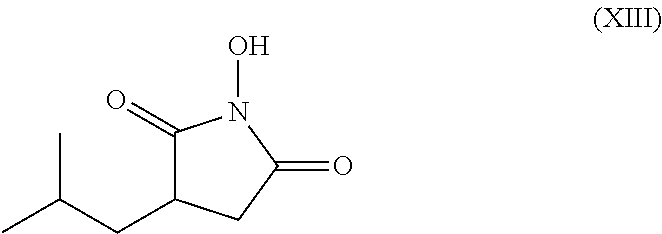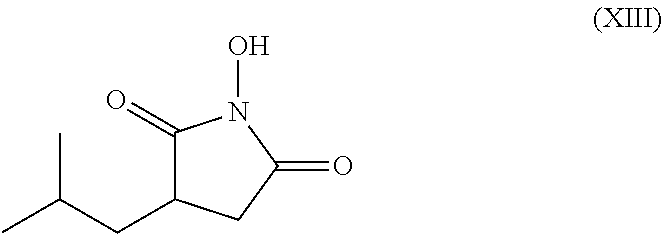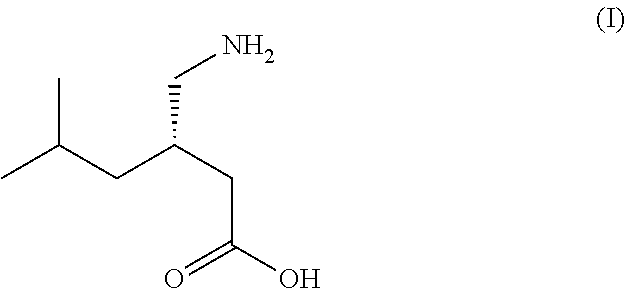Process for the stereoselective enzymatic hydrolysis of 5-methyl-3-nitromethyl-hexanoic acid ester
a technology of enzymatic hydrolysis and hexanoic acid, which is applied in the field of stereoselective enzymatic hydrolysis of 5methyl3nitromethylhexanoic acid ester, can solve the problems of limiting its use on an industrial scale, low efficiency, and long compound length, and achieves convenient separation and more economical effects
- Summary
- Abstract
- Description
- Claims
- Application Information
AI Technical Summary
Benefits of technology
Problems solved by technology
Method used
Image
Examples
example 1
Synthesis of 2-(3-methyl-butylidene)-malonic acid diethyl ester (XI, R1=R2=ethyl)
[0168]3-Methylbutyraldehyde (145.2 g; 1.69 mol, compound VI) was dissolved in 400 mL of hexane.
[0169]9.6 g of acetic acid (0.16 mol) and 8.1 g of di-n-propylamine (0.08 mol) were added. To this solution 256.3 g (1.60 mol) of diethylmalonate were added. The reaction mixture was heated to reflux. Water was continuously removed using a Dean Stark trap until complete conversion of the starting material was observed. The reaction mixture was cooled to room temperature and was washed twice with 200 mL of water, once with 160 mL of 1M aqueous NaOH, and once with 5% aqueous NH4Cl. The organic layer was dried by azeotropic distillation and the solvent was removed under reduced pressure to give 374 g of crude 2-(3-methyl-butylidene)-malonic acid diethyl ester (97% yield; compound XI, R1=R2=Et). A small part of the crude product was purified by vacuum distillation (bp 95° C., 1 mbar).
[0170]
[0171]1H-NMR (CDCl3, 300...
example 2
Synthesis of 2-(3-methyl-1-nitromethyl-butyl)-malonic acid diethyl ester (XII, R1=ethyl)
[0173]2-(3-Methyl-butylidene)-malonic acid diethyl ester (30.0 g, 0.131 mol, compound XII, R1=ethyl) was dissolved in 35 mL of nitromethane. The solution was cooled to 0° C. and 3.3 mL of 1,1,3,3-tetramethylguanidine (0.026 mol) were added within 30 minutes. The reaction mixture was stirred at 0° C. for one hour and then for four hours at 25° C. GC analysis indicated complete conversion. 40 mL of 2M aqueous HCl were added and after stirring for 5 minutes the layers were separated (20 mL of saturated aqueous NaCl were added to facilitate the layer separation). The aqueous layer was washed twice with 100 mL of methyl tert-butyl ether. The combined organic layers were washed once with 50 mL of saturated aqueous NaHCO3 and 25 mL of water. The organic phase was dried and thereafter concentrated under reduced pressure to give 2-(3-methyl-1-nitromethyl-butyl)-malonic acid diethyl ester (XII, R1=R2=ethyl...
example 3
Synthesis of 5-methyl-3-nitromethyl-hexanoic acid ethyl ester (VIII, R1=R2=ethyl)
[0177]10.0 g (34 mmol) of 2-(3-methyl-1-nitromethyl-butyl)-malonic acid diethyl ester (XII, R1=ethyl) were dissolved in 140 mL of DMSO. Water (10.4 mL) and solid NaCl (14.6 g) were added and the mixture was heated for 6 hours at 150° C. After complete conversion, the reaction mixture was cooled to 25° C. and 150 mL of methyl tert-butyl ether were added. 100 mL of water were added slowly. The heterogeneous mixture was stirred for 5 minutes prior to layer separation. The aqueous layer was washed once with 75 mL of methyl tert-butyl ether. The organic layers were combined and washed once with 50 mL of water. The combined organic layers were dried and the volatiles were removed under reduced pressure to give 7.0 g of 5-methyl-3-nitromethyl-hexanoic acid ethyl ester (VIII, R1=ethyl; 93% yield).
[0178]
[0179]1H-NMR (CDCl3, 300 MHz) δ (ppm)=0.78 (t, 2×CH3, 6H, J 7.0 Hz), 1.12 (t, CH2, 2H, J 7.0 Hz), 1.13 (t, CH3...
PUM
| Property | Measurement | Unit |
|---|---|---|
| enantiomeric excess | aaaaa | aaaaa |
| enantiomeric excess | aaaaa | aaaaa |
| enantiomeric excess | aaaaa | aaaaa |
Abstract
Description
Claims
Application Information
 Login to View More
Login to View More - R&D
- Intellectual Property
- Life Sciences
- Materials
- Tech Scout
- Unparalleled Data Quality
- Higher Quality Content
- 60% Fewer Hallucinations
Browse by: Latest US Patents, China's latest patents, Technical Efficacy Thesaurus, Application Domain, Technology Topic, Popular Technical Reports.
© 2025 PatSnap. All rights reserved.Legal|Privacy policy|Modern Slavery Act Transparency Statement|Sitemap|About US| Contact US: help@patsnap.com



